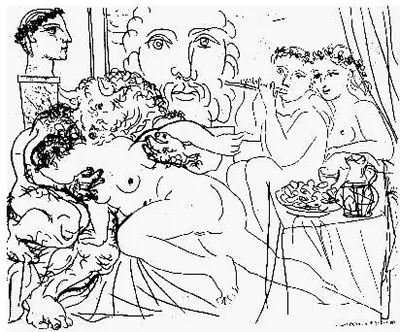Picasso was commissioned by French art dealer Ambroise Vollard to create 100 prints between 1930 and 1937. This project coincided with Picasso's neoclassical art period in which many of his pieces show inspiration from Greek mythology and art. It therefore makes sense that Picasso would frequently feature the Greek half-human, half-bull creature, the Minotaur, in this series, including Minotaur Caressing a Woman.
The Minotaur carried much significance for Picasso. Those who study Picasso believe the creature is partially representative of the art of bullfighting, which he admired, as it originated in his home nation of Spain. Picasso also understood the creature to be a metaphor for the paradox of good and evil that exists in everyone. It is also a common understanding that Picasso identified with the Minotaur as he has both human and animal characteristics, much like the creature with the head of a bull and the body of a man. These feelings of similarity to a Minotaur are reflective of the personal struggles Picasso was experiencing during the creation of this series.
In Minotaur Caressing a Woman, Picasso depicts the creature in a romantic embrace with a human female, whose face is hidden. This representation of the female character is different than many of the other etchings because her face is usually visible. When it is visible, the face has a strong likeness to Picasso's mistress, Marie-Thérèse Walter. This relationship understandably caused trouble between Picasso and his wife, Olga. While Picasso often depicts Marie-Thérèse with the Minotaur, which is symbolic of Picasso himself, this painting leaves a question in the air. Is the woman the mistress? Is she the wife? It could simply be proof that Picasso had trouble choosing between the two women in real life and therefore left the face hidden in his art. The answer is something only the artist would truly know.

